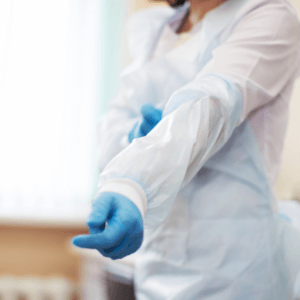Forensic Cleaning Services | Importance of Top-Down Antimicrobials
Forensic Cleaning Services: Importance of Top-Down Antimicrobials after an Unattended Death
Summary
Top-down antimicrobial cleaning is essential after an unattended death, ensuring health, safety, and dignity. It starts from the highest points, using antimicrobial agents to eliminate pathogens and prevent infection. The meticulous process includes biohazard removal, deep cleaning, special attention to high-touch areas, HEPA air filtration, and sanitising porous materials. Forensic cleaning services conduct these tasks with professional equipment and sensitivity, providing a safe, respectful environment for the bereaved.
In the unfortunate event of a death occurring on a property, the necessity of top-down antimicrobial cleaning becomes paramount. This process is not only vital for health and safety reasons but also for ensuring a respectful and dignified handling of such sensitive situations by forensic cleaning services.
Understanding Top-Down Cleaning
Top-down cleaning refers to the comprehensive cleaning process that starts from the highest points in a property and works downwards. This methodical approach ensures that every surface and corner is thoroughly cleaned and sanitised, leaving no area overlooked.
Antimicrobial Agents: The First Line of Defence
The use of antimicrobial agents by forensic cleaning services is crucial. These agents are designed to eliminate bacteria, viruses, and other harmful microorganisms, reducing the risk of infection or illness. In a scenario following a death, these agents play a pivotal role in ensuring the environment is safe and hygienic for continued use.
The Process of Antimicrobial Cleaning
The process of antimicrobial cleaning, especially after an event as solemn as a death in a property, is a meticulous and multi-layered procedure. It begins with an assessment phase, where the area to be cleaned is evaluated for biohazard risks and the extent of microbial presence. Following this, a step-by-step protocol is enacted to ensure safety and thoroughness:
Initial Removal of Biohazardous Materials:
The first step involves carefully removing any biological materials that pose a risk of infection. This is done with precision and care to prevent any potential spread of pathogens.
Decontamination:
After the removal of biohazardous substances, the area undergoes a decontamination process using EPA-registered disinfectants. This phase is crucial for neutralising any microscopic threats that linger.
Deep Cleaning of All Surfaces:
Following decontamination, all surfaces within the property are subjected to deep cleaning. This includes walls, floors, ceilings, and any fixtures. The use of hospital-grade disinfectants ensures that all areas are free from contaminants.
High-Touch Areas:
Special attention is paid to high-touch areas such as doorknobs, light switches, countertops, bathroom fixtures, and kitchen appliances. These points are often the most contaminated and require thorough sanitisation.
Air Filtration and Ventilation:
To address airborne pathogens, high-efficiency particulate air (HEPA) filters are used alongside proper ventilation techniques. This helps in capturing and removing particles that may carry microorganisms.
Sanitising Soft Surfaces:
Carpets, curtains, and upholstered furniture are treated with appropriate cleaning agents. Given their porous nature, these items can harbour pathogens and thus need specific antimicrobial treatments.
Final Inspection and Testing:
The area is then reinspected to ensure all cleaning protocols have been followed. Surfaces may be tested for microbial activity to confirm the efficacy of the cleaning process.
Preventative Measures:
Finally, preventative measures are implemented. These may include the application of antimicrobial coatings that provide a long-term barrier against the growth of bacteria, mould, and other harmful microbes.
This comprehensive approach to antimicrobial cleaning ensures that the environment is not only visually clean but also microbially safe, providing peace of mind to the inhabitants and all who may enter the property thereafter.
Safety Measures and Protocols
Safety is paramount in top-down antimicrobial cleaning. Professional forensic cleaning services undertaking this task are equipped with personal protective equipment (PPE) and follow strict protocols to ensure their safety and the safety of others.
The Emotional Aspect of Cleaning After a Death
Cleaning a property after a death is not just a physical task but also an emotional one. It involves handling personal belongings and being respectful of the memories and sentiments attached to them. Forensic cleaning services are trained to handle such situations with empathy and discretion.
Ensuring a Safe and Respectful Environment
The ultimate goal of top-down antimicrobial cleaning after a death in a home is to provide a safe and respectful environment for the bereaved. It’s about restoring a sense of normalcy and peace, allowing families to focus on healing and remembrance.
The Role of Forensic Cleaning Services
Forensic cleaning services are equipped with the expertise, equipment, and sensitivity required to handle situations involving biohazards, such as unattended deaths. They ensure that the cleaning process is thorough, respectful, and meets all health and safety standards.
In conclusion, the importance of top-down antimicrobial cleaning after a death in a property cannot be overstated. It’s a crucial service provided by forensic cleaning services that ensure safety, comfort, and peace of mind during a difficult time.
FAQs
What are antimicrobials and how do they work?
Antimicrobials are agents that kill microorganisms or stop their growth. They work by targeting specific structures or functions in the microorganism that are critical for its survival or reproduction.
What does forensic cleaning involve?
Forensic cleaning refers to the thorough cleaning and sanitisation of scenes where serious incidents, such as crimes, accidents, or unattended deaths, have occurred. It involves the removal of biohazardous substances, decontamination, and restoration of the area to a safe and non-hazardous state.
How are forensic cleaning services different from regular cleaning services?
Forensic cleaning goes beyond the scope of regular cleaning by dealing with situations that pose biological hazards. It requires specialised knowledge of bloodborne pathogens, chemical use, and proper disposal of biohazardous waste. Regular cleaning services focus on everyday cleaning tasks and typically do not handle biohazardous materials.
Why Choose AllAces?
AllAces Cleaning & Restoration has more than 35 years of industry experience handling extensive forensic cleaning and biohazard cleanup in both domestic and commercial sectors. Our IICRC-certified technicians utilise the latest technology and equipment to ensure the return of a safe and habitable environment.



